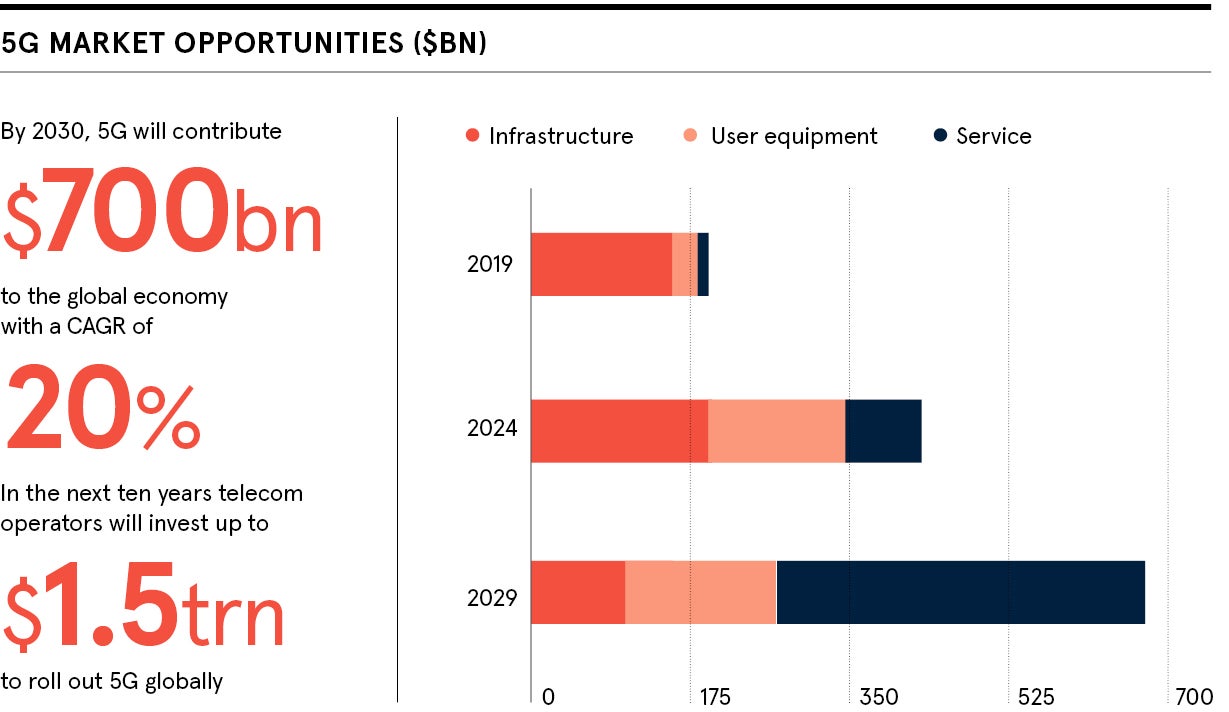By 2030, 5G is forecast to contribute $700 billion to the global economy with a compound annual growth rate of 20 per cent. This is a revolutionary rise that will both accelerate the growth of the telecommunications industry and redefine a whole host of industrial, entertainment and IT sectors in its wake.
Its arrival is imminent too, with the United States and South Korea already having launched commercial consumer 5G networks in April 2019 to great effect. Subsequently, more than half of all telecoms operators around the world have sped up their 5G rollouts and targeted a commercial launch in either 2019 or 2020. China alone expects 5.8 per cent of its GDP growth to derive directly from 5G technology by 2030.
So how can business leaders and those responsible for innovation benefit from the infrastructure, user equipment and services that come with 5G?
The first wave of 5G investment is the deployment of 5G infrastructure. The US and South Korea spent $41 billion while the global capital expenditure on 5G was around $161 billion in 2018. Over the next ten years, global telecom operators will invest $1.2 trillion to $1.5 trillion on 5G network rollouts, most of which will be for sub 6GHz 5G.
Global capex on 5G was around $161 billion in 2018
Companies accounting for the largest share of infrastructure investments include heavyweights such as Ericsson, Nokia and Huawei. The largest supplier with a 28 percent global market share, Huawei, has signed more than 40 commercial 5G contracts and shipped more than 70,000 base stations already.
However, future competition is still unclear as the US government increases pressure on many countries to ban Huawei from supplying equipment for 5G networks. Samsung has already moved to enhance its position and dominates South Korean 5G deployments with more than 53,000 base stations installed.
The second wave of 5G investment will comprise new 5G user equipment. More than 40 commercial 5G devices, most of which are 5G smartphones, will reach global markets in 2019, with a mission to rescue a declining global mobile market. Pioneers include the Samsung S10 5G, Huawei Mate X and the Motorola 5G moto mod. With the agreement to drop all litigation with Qualcomm, Apple is also likely to launch its 5G iPhone soon.
Additionally, the customer premises equipment market is set to deliver economically viable broadband services to homes and small and medium-sized enterprises on top of their existing mobile broadband offerings. Increasingly, devices such as augmented and virtual reality glasses, 8K TVs and wearables will integrate with 5G, creating a significant growth in the technology market which is expected to exceed hundreds of billions of US dollars by 2025.
A primary reason for such a spike derives from the market opportunities 5G presents. 5G enables the possibility to link various wireless services to one universal cellular network. These various vertical applications will create a whole new world of technology products.
The potential for a range of segment growth in support of 5G is unprecedented. Sectors including automotive (autonomous drive, in-car entertainment systems), industry 4.0 (remote-controlled robots and drones, intelligent machines), media experiences (5G TV, cloud game-streaming) and healthcare (remote diagnostics and surgery, digital health) are all set to be influenced by the impact of 5G.
IDTechEx provides research, consultancy and events to a wide range of businesses to enable them to make strategic decisions to capitalise on 5G and other emerging technology opportunities. For more information please visit www.IDTechEx.com/5GTimes

